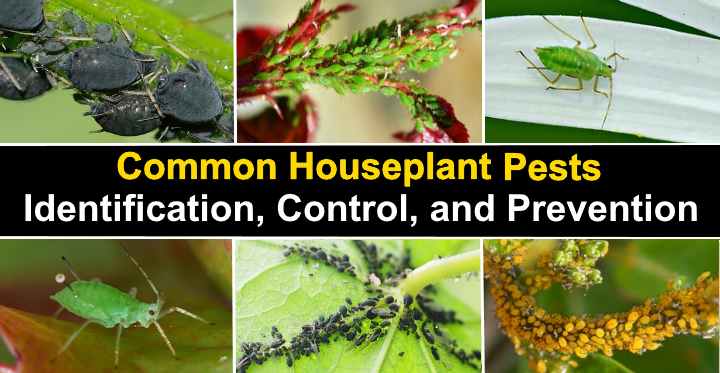Indoors, houseplant pests reproduce quickly and invade many of your beloved plants. Houseplant bugs may thrive in the perfect conditions indoors: warmth, moisture, and light. Getting rid of common indoor plant pests quickly involves knowing how to identify them. To avoid infestations from spreading out of hand, it is also important to check on houseplants frequently for indications of plant pests.
Indoor plants are less likely to be attacked by common pests if they are properly cared for. According to scientists, stressed plants are vulnerable to houseplant insects. Weak growth, leaf color changes, stem and leaf speckles, webbing beneath leaves, or wilting are all symptoms of the problem. Pest management is essential when caring for houseplants because it is difficult to get rid of indoor plant pests.
You’ll find out how to recognize the most prevalent insect and bug species that plague houseplants in this article. Images and their scientific names will help with identification, along with descriptions of the annoying insects. You’ll learn natural ways to exterminate insects on houseplants as well.
Always remember to immediately isolate any insect discovered on a houseplant from your other indoor plants. This will help you eliminate indoor plant pests effectively and prevent future infestations.
Types of Houseplant Pests
Tiny aphids, which may be yellow, brown, red, green, white, or black in color are among the different kinds of houseplant bugs. Mealybugs are tiny flufflike pieces of white fluff that cling to plant stems and leaves. Thrips are green, black, or brown bug that have pointed tails and a long body. Microscopic spider mites are houseplant pests that cause fuzzy webs on leaves and stems, despite the fact that they are difficult to see.
Fungus gnats are one of the most common houseplant pests that you’ll find on the plant’s leaves or in the soil. The larvae of these soil-dwelling pests, which resemble tiny dark flies, might wreck roots if they get into them. Aphids, whitefly, spider mites, thrips, mealybugs, and scale are all common pests that feed on indoor plant leaves.
Houseplant Bugs and Pests (With Images)
Let’s learn more about the most prevalent houseplant pests now that you know what they are. Before your indoor plants do serious harm, identifying the sort of insects or pests on them will assist you manage them.
Aphids
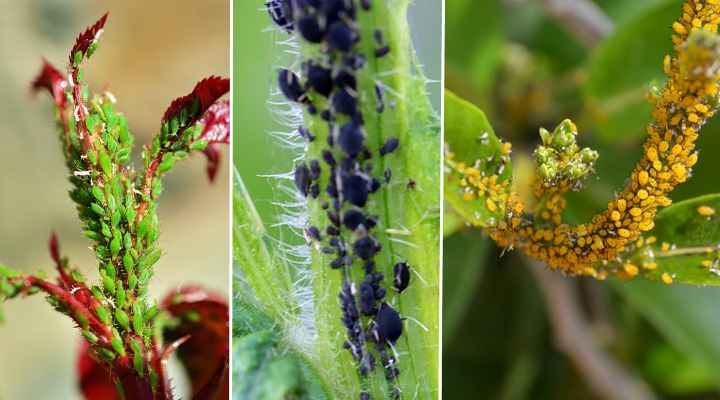
Aphids are tiny green insects that may range in color from red, yellow, black, or white. They are pests that suck the juice from houseplants and kill them. Greenfly or blackfly are common names for these common houseplant pests from the superfamily Aphidoidea. Wasps, ladybugs, and larvae are all predators that help keep aphid numbers in check outdoors. Indoor aphids, on the other hand, because there are no predators, reproduce quickly in houseplants.
How to identify aphids on houseplants
Aphids, which are just 3 mm long, are tiny pests. They’re more difficult to detect on plants because they’re often green. Nevertheless, black, yellow, red, brown, or blue are all possible colors for these tiny plump insects. Sap-sucking plant pests include fluffy white woolly aphids.
You may observe clusters of these tiny fat insects on young stems and leaves if you have an aphid houseplant infestation. A viscous material, as well as black sooty mold fungus, may be seen on the leaves. Withering leaves can be symptoms.
How to get rid of pests from plants indoors
Getting rid of aphids from plants is notoriously difficult. Most of the insects may be dislodged with a good spray of water. After that, you should wash the plant’s leaves and stems with mild soap.
Mix 1 tsp. of baking soda and 1 tbsp. of honey with water to make an aphid-destroying natural spray 33 fl. oz. of organic mild liquid soap Warm water (1 l). Apply daily until the aphids have gone, using a spray bottle. Neem oil and rubbing alcohol are two more ways to get rid of aphids on houseplants.
Fungus Gnats (Soil Gnats)
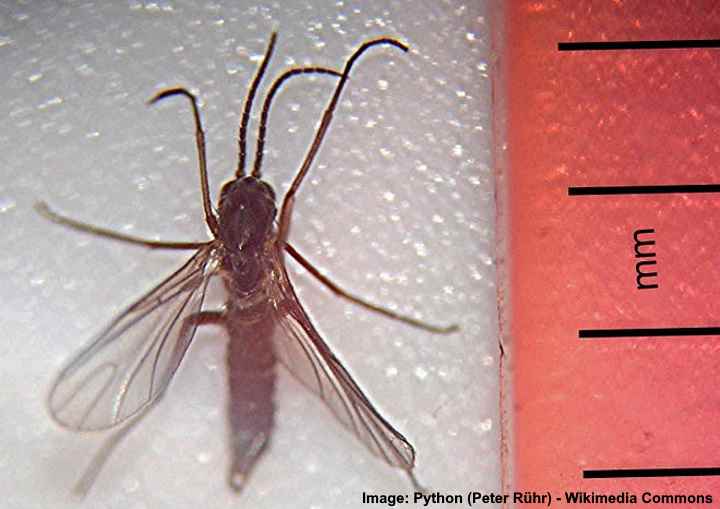
Fungus gnats are little black houseplant pests that feed on fungus and dwell in the soil. The Sciaridae family of tiny, black-winged flies are rarely harmful to healthy houseplants. If the infestation is heavy, they lay eggs in the soil and their larvae may damage roots.
Fungus gnat larvae, on the other hand, are mostly root feeders. Fungal infections can be brought by over-watering indoor plants, which attract these little black bugs.
Fungus gnat identification on plants
Since they resemble little fruit flies crawling across the soil or flying around your plants, identifying fungus gnats on houseplants is simple. Fruit flies are drawn to fruit and garbage, not your favorite houseplants, as the difference between fungus gnats and fruit flies.
Adult fungus gnats swarm around plants and range in size from 0.08 to 0.3 inch (2 to 8 mm). While they don’t seem to do any harm to plants, they’re a problem indoors.
How to get rid of bugs on indoor plants
Use Bacillus thuringiensis var. israelensis to get rid of fungus gnats on houseplants. Bti or H-14 is the Hebrew name for Israelensis. This is a natural product that kills fungus gnat larvae in potting soil. This is the only effective natural fungus gnat insecticide, according to scientists.
Keep humidity in houseplant soil to a minimum to avoid fungus gnats affecting your plants. Before repotting, you may need to replace the potting soil and clean the pot.
Diatomaceous earth (DE) is another option to get rid of fungus gnats. By destroying the outer layer of gnats and other houseplant pests, this natural silica powder kills them. For DE to work on fungus gnats, the soil must be dry. To catch the little flying gnats, you might also use yellow sticky stakes.
Mealybugs

Another kind of sap-sucking bug that may wreak havoc on your houseplants is mealybugs, which look like little white fluffy bugs. The Pseudococcidae family includes these tiny white fuzzy creatures. Mealybugs, which suck on plant sap and will eventually starve to death if not treated, are fascinating pets.
How to identify mealybugs on indoor plants indoors
Mealybugs are small white insects that look like dust or cotton wool flecks on your indoor plant. The oval, segmented body of the little white insects is about 0.25 inch (6 mm) long. The sap-sucking insects prefer to reside in the main stem and leaf stems’ joints. Leaf yellowing caused by the plant’s weakening and eventual death is another indication of mealybugs. On plant stems, you may also see honeydew, which is a sticky substance containing black sooty molds.
How to get rid of mealybugs in houseplants
On indoor plants, it’s important to remove mealybugs as soon as you see one. To destroy the white insects on touch, use rubbing alcohol. Treat the plant with a cotton bud every day after applying the alcohol. Continue treating your plant until you can’t find any evidence of mealybugs anywhere.
Spider Mites

Spider mites on a lemon tree in the left picture. Spider mites are a common householdplant pest that may infect your indoor plants and cause severe damage. The family Tetranychidae contains these tiny spider-like insects. Because they only measure 0.04 inches (1 mm), they are difficult to spot.
However, webbing beneath plant leaves is left behind. Plant sap is eaten by spider mites, which kills the plants. Leaves eventually lose their color and die over time.
Spider mite identification on house plants
Checking for silky spider webs on your plant is the most common way to identify spider mites. Since they are so little, individual bugs are difficult to see. Spider mites are typically visible on plants when the infestation is substantial. Before purchasing plants from a garden center, make sure there aren’t any spider webs.
Getting rid of indoor houseplant pests naturally
It is vital to act immediately when you see signs of spider mite infestations on indoor plants. Sap-sucking mites can be quickly eliminated with the help of neem oil.
Mix 1.5 tsp. of neem oil with enough distilled water to make a spray solution. 1 tsp. of neem oil is added to the mixture. 33 fl. oz. liquid soap Warm water (1 liter) To get rid of the majority of the insects, thoroughly wash your plant leaves. Weekly, apply neem oil to your plants to eliminate spider mites.
Continue to apply neem oil every two weeks as a preventive measure even after the spider mites have gone. Spider mites prefer dry, warm environments, so maintaining humidity levels high is a good way to prevent them from returning.
Whitefly

The underside of the houseplant’s leaves are usually covered with tiny whiteflies. This insect is a tiny white-colored fly that may harm plants if the invasion is considerable. The image on the right shows it feeding on whitefly larvae. The Aleyrodidae family of winged insects includes Whitefly. They may range in size from microscopic to 0.07 inch (2 mm) and live on the underside of plants.
A swarm of whitefly emerges from under the leaves when you disturb an infested plant. Mealybugs crawl, while whiteflies fly. This is one way to distinguish the two insects. Whiteflies, like mealybugs, aphids, and thrips, can also harm plants.
How to identify whitefly infestation on houseplants
Turn leaves over to identify little whiteflies on indoor plants. Search for signs of whitefly. It is critical to eliminate whiteflies as soon as you detect them. They reproduce quickly, and their sap-sucking feeding habits harm the development of your indoor plants.
How to get rid of bugs from plants
These tiny whiteflies may be eliminated from plants in a variety of ways. To lower their numbers, for example, you might use yellow sticky traps. For insect pests on houseplants mentioned in the article, you may also use neem oil spray. Neem oil, on the other hand, is only effective against the eggs and larvae since whiteflies fly away when the plant is disturbed.
To control these houseplant pests, spray them frequently to disrupt the whitefly lifecycle. Trim off and dispose of severely infested leaves in the trash outdoors.
Thrips

Several black or brown species of thrips (upper images) belong to this group. Leaf infected with thrips (left) has lower photos. Thrips are tiny black or brown bugs that may be seen creeping over houseplants. They damage coffee tree leaves by rolling them up (right). Tiny insects in the order Thysanoptera, roughly 0.04 inch (1 mm) long, are common indoor plant pests.
Thrips are one of the most bothersome house pests for many indoor plant owners. They move quickly from plant to plant, making widespread infestations as they crawl and fly. Thrips are bigger insects that survive in the soil, unlike fungus gnats. They go up the plant stems and beneath the leaves, moving across the soil. They cause stunted growth and discolored leaves by feeding on the sap of houseplants.
How to identify thrips on house plants
Because of their long thin black bodies and pointed tails, thrips are simple to spot. These long, slender insects are typically black, although they may be brown, greenish-yellow, or white. They’re rather common on the underside of leaves. Baby thrips can be seen as tiny white or yellowish-green specks. Brown stripes on leaves, leaf drop, or portions of the plant dying are all indications of a thrip infestation.
How to get rid of thrips from plants indoors
Getting rid of thrips may be difficult. So, it’s all about perseverance. Washing leaves with insecticidal soap is one home remedy for getting rid of thrips. The tiny black insects on your plant are killed by soap. Remove any residue after thoroughly washing the leaves. Make sure that the soap won’t harm your plant by testing it on one leaf.
The neem oil solution is another option for getting rid of trips on houseplants. Once a week, spray neem oil solution on plant leaves. When thrips come into contact with it, some of the natural insecticide kills them, while others die.
Scale
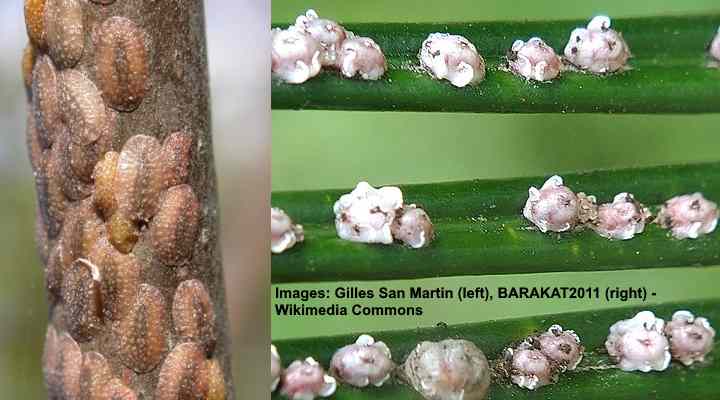
Left picture: Scale insects on a stem. Scale insects are scale insect pests that sap-feed on plant sap and may cause significant harm to indoor plants. These little brown bugs are usually seen on houseplant branches and leaf seams and belong to the Coccoidea superfamily. Since they come in a variety of forms, sizes, and colors, scale insects are difficult to differentiate.
How to identify scale insect pests on houseplants
Indoor plants’ scale is difficult to detect. Insect pests that are small don’t crawl, scurry, or fly. Instead, they might look like a little growth on stems that are brown in color. They’re often brown, although they might range in color from white to reddish-brown. When their population increases, these houseplant pests create clusters of bumps on stems and leaf joints, making them easier to spot.
How to get rid of pests from indoor plants
Try using rubbing alcohol to get rid of scale bugs on houseplants. Alcohol can be used to kill scale insects on contact by using a cotton bud. Scale insects like to hide in nooks and crannies, so check every part of the plant. Additionally, inspect the stems for signs of scale insects by removing some soil.
One of the soil-dwelling houseplant pests is scale. Repotting the infested plant in fresh potting soil is a good option if you have scale on your plants. If you’re using the same pot, remember to sterilize it first.
Broad Mites
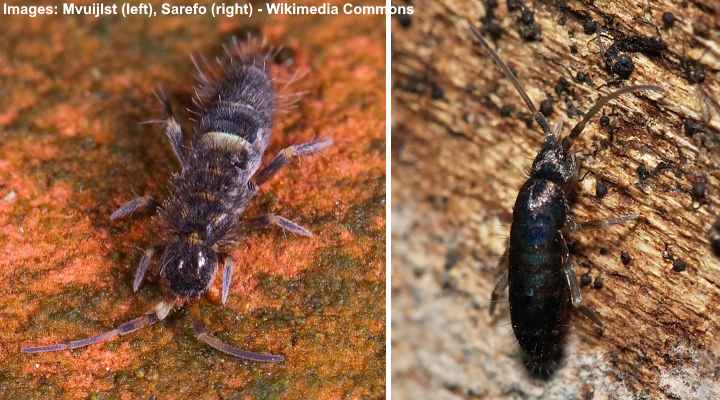
Little houseplant pests that attack broad mites. Broad mites, also known as large mites, are tiny plant pests that can harm a variety of plants, including indoor tropical plants. These tiny-teeny bugs feed on plants and belong to the insect genus Polyphagotarsonemus.
How to identify broad mites
Since mites are so tiny, they can’t be seen with the naked eye. Curling leaves and poor development are indicators of a widespread mite infestation. Getting rid of these indoor plant pests is difficult. As a result, the only effective way to avoid future plants from becoming infected is to destroy them all.
Springtail
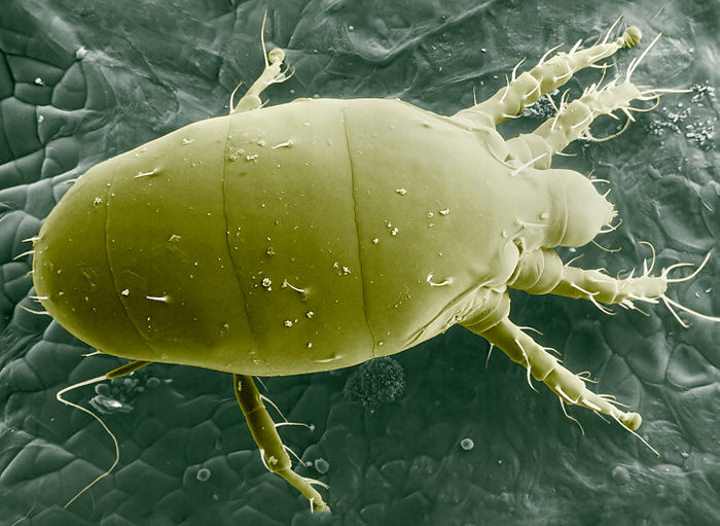
Springtails are a kind of long skinny black bug with antennae that lives in the soil of houseplants. They are tiny little creatures that dwell in the soil. While they may feed on roots, springtails (Collembola) seldom cause lasting harm to plants and prefer wet soil.
How to identify springtail
These little insects have a segmented body with a fuzzy look and grow up to 0.24 inch (6 mm) long. Avoiding soil from becoming waterlogged or excessively wet is the best way to minimize springtails. These houseplant bugs can be eliminated by sprinkling diatomaceous earth over the top of dry potting soil.
How to Prevent Houseplant Pest Infections
It’s a time-consuming and infuriating process dealing with houseplant pests like aphids, bugs, and spider mites. Adults may perish off in the life cycles of various insects, but eggs may develop and the issues begin anew. Eliminating all types of indoor plant pests requires prevention. Guidelines for preventing common plant pests from harming your prized houseplants are listed below:
- Always check the outside of plants you purchase at garden centers or stores for evidence of insect or bug activity. Webbing, tiny flies, oddities on leaves, and brown lumps on stems are the most prevalent ones.
- For pests, inspect the underside of leaves.
- Aphids or mealybugs could be detected by looking for sticky secretions on stems.
- Healthy plants are less prone to pests, so provide the ideal environment for their growth.
- Instead of using garden soil, use commercially prepared potting soil.
